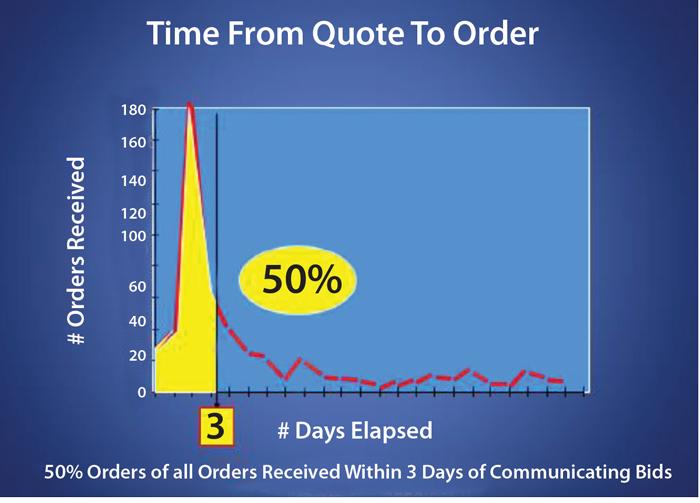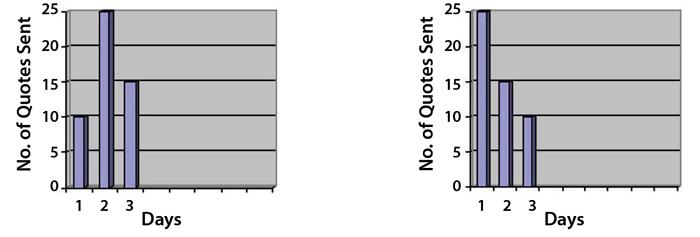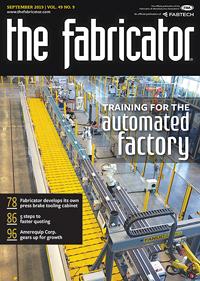President
- FMA
- The Fabricator
- FABTECH
- Canadian Metalworking
Categories
- Additive Manufacturing
- Aluminum Welding
- Arc Welding
- Assembly and Joining
- Automation and Robotics
- Bending and Forming
- Consumables
- Cutting and Weld Prep
- Electric Vehicles
- En Español
- Finishing
- Hydroforming
- Laser Cutting
- Laser Welding
- Machining
- Manufacturing Software
- Materials Handling
- Metals/Materials
- Oxyfuel Cutting
- Plasma Cutting
- Power Tools
- Punching and Other Holemaking
- Roll Forming
- Safety
- Sawing
- Shearing
- Shop Management
- Testing and Measuring
- Tube and Pipe Fabrication
- Tube and Pipe Production
- Waterjet Cutting
Industry Directory
Webcasts
Podcasts
FAB 40
Advertise
Subscribe
Account Login
Search
5 steps to faster quoting in the job shop
Metal fabricators that quote quickly can grow quickly
- By Vincent Bozzone
- September 3, 2019
- Article
- Shop Management

Custom fabricators that scrutinize their quoting process, reducing or eliminating unnecessary steps and associated waste, can gain a huge competitive edge and financial growth. Getty Images
In custom metal fabrication and other job shops and custom manufacturing companies, shortening lead time is the golden road to profitable growth. Reducing the amount of time your customers must wait to have their needs met is the single most powerful strategy you can follow to strengthen your company’s competitive position. Why? Because in today’s world, faster service is much more valuable than slower service.
The same logic applies to quoting. Those who can turn request for quotations (RFQs) around quickly, before the competition, have a significantly greater chance of winning that order. If you want to increase sales, quote faster, because your customers are waiting.
The race to complete an order begins not when you win that order, but instead when you discover a customer’s need. During every activity that occurs in between, the clock is ticking.
Consider one study a job shop conducted for 1,794 RFQs over one year. The shop found that more than 50 percent of its winning bids were received within three days after the job shop sent its bid to the customer (see Figure 1).
What does this mean? Normally, we think of the quoting process as one in which a customer prepares specifications and sends RFQs to three or more potential suppliers. These suppliers then prepare estimates that the job shop’s sales department converts into quotes, which are then sent back to the customer. The customer waits to receive all quotes, compares them, and then makes a rational decision based on price, delivery time, and other factors.
But it doesn’t’ always work this way. Many times customers have an urgent need. Somebody forgot to order the parts, a previous shipment was unusable, inventory records were inaccurate, or one of their customers pushed a delivery date forward. Whatever the reason, customers urgently need what you supply, so they bypass the normal quoting process.
In these cases, getting your quote in front of the buyer before your competitors do gives you a huge advantage, because the important thing for that customer is to get what you supply as quickly as possible. Do you think buyers are going to sit around and wait for all the quotes to dribble in, hoping to save a few pennies, when they have an urgent and costly problem on their hands? Hardly.
Quoting time depends on the type of work a job shop does, of course. Industrial fabricators quoting large, complex projects will take longer to quote than a sheet metal shop quoting laser-cut parts. But generally speaking, if it takes you more than three days to get a quote back to customers, chances are that order has already been awarded and is being worked on in someone else’s shop.
So what can you do to shorten your quoting time? Try the following steps.
1. Eliminate Delays
Consider the entire quoting process, including all the departmental hand-offs. The end-to-end process involves receiving an RFQ, converting that into a quote, and communicating that quote to the customer.
Figure 1
One job shop conducted a study and found that, out of 1,794 RFQs over a year, more than 50 percent of its winning bids were received within three days after the job shop sent its bid to the customer
For example, you might receive an RFQ and send it to sales for review, then to estimating for costing, then back to sales for pricing, then maybe to the owner for approval, then to the person who prepares the paperwork and sends it to the customer. Each of these steps involves two types of delays. One occurs in the “dead space” between steps, when the quote fails to move along from one person or one step to another. It just sits there, dead in the water.
What causes the dead space? It might have to do with how people in the office sequence the tasks over their workday. For instance, estimators might wait until they complete a batch of quotes, perhaps at the end of the day, before sending them on to the sales department for pricing. This loses an entire day to dead space, as RFQs sit on desks or within computer files. Or RFQs might sit at a fax machine or email inbox all day while administrative personnel deal with other matters they mistakenly believe are more important. What’s the result? Another day lost.
You can eliminate or at least minimize delays between steps by streamlining the process, taking out unnecessary steps, making sure people understand the need to move RFQs quickly, and making sure that turning around RFQs quickly is a top priority.
A second type of delay occurs within steps, like when someone spends too much time on a particular step in the quoting process. For example, many times the estimating process is far too detailed and time-consuming than it needs to be. The added accuracy is not worth the time spent to achieve this level of precision. Other methods will yield a “close enough” estimate that’s faster and less cumbersome.
2. Don’t Wait for Outside Vendors
Often estimates are delayed because you’re waiting to get a price from outside vendors, such as for heat treating, powder coating, machining, or other services. Consider alternative ways of working with these vendors so they do not delay your ability to respond to RFQs quickly. For example, try establishing preset prices for standard services they perform. Eventually a vendor might institute a fast-track quoting process for its key customers once it understands the importance of turning around RFQs quickly.3. Build a Quote Database, Track Performance
Estimating can be both more accurate and efficient if you measure and track your quoting process—specifically, the results of each RFQ received and quotes submitted. Good information to collect includes the quoted price; whether the order was won or lost; the time from quote to receipt of order; customer contact information; product information; whether it’s a new or a repeat customer; the total dollar value quoted; the total dollar value won; expected versus actual margins; and the wins by estimator. Collecting, organizing, and analyzing this information is extremely valuable for any company that wants to understand more about its customers and its own performance. It also provides a way to follow up on outstanding quotes, increasing customer contact.
Figure 2
These simple histograms show the number of days and the number of quotes sent to customers. The right-hand histrogram shows an improving situation, with more quotes being turned around in a day or less.
4. Manage the RFQ Backlog
The flow of RFQs into any job shop is never level or consistent. Sometimes the shop estimators might be overloaded with an avalanche of RFQs; other times RFQs trickle in—it’s the feast-or-famine cycle of the typical job shop. Problem is, when the number of RFQs increases, they take longer for estimators to turn around. To solve this problem, you need to add estimating capacity when the RFQ backlog increases. How, exactly? One way is to separate the complex from simple estimates and assign those simple quotes to a junior estimator. Or you might automate a portion of the quoting process. Or during peak times, you might review RFQs beforehand and be more selective in those you choose to quote. And yes, it’s difficult for job shops to turn down work, simply because it’s an order-driven business—and you often don’t know when the next order will come in. But taking on more RFQs than you can handle creates a quoting bottleneck, delaying a portion of or even all RFQs in the pipeline. It’s similar to accepting jobs that you can’t deliver on time—and in one sense, a won order and an RFQ are both “jobs” that require capacity. The order requires fabricating capacity; the RFQ requires quoting capacity.In the long term, you continually work to increase capacity, both in quoting and in manufacturing. But in the short term, something has to give. You need to create capacity before you take the order, or you wind up losing your shirt in the long run as customers find you to be unreliable.5. Follow up With Customers
You send a quote to a customer in a day and your job is done, right? Hardly. Follow up to make sure the customer received the quote and all is in order. A follow-up phone call gives your salespeople an opportunity to answer questions the customer might have, as well as to tout the benefits of having your company perform the work. In this age of relationship-selling, more contact is better than less contact, and following up on RFQs is an ideal way to reinforce and build solid relationships with your customers. As Henry Ford is purported to have said, “All things being equal, do business with your friends. All things not being equal, you still do business with your friends.”Quote Faster, Grow Faster
A quote sitting in someone’s inbox for days can be just as bad as excessive work-in-process sitting between shop operations—and in some ways, it’s worse. Think of a major customer at your company. Chances are that customer wasn’t always such a large account. The relationship probably started with just one small order and grew over time into something huge. Of course, if you take forever to turn around that first quote, the entire relationship won’t get off the ground. The opportunity costs could be tremendous.Speed has taken its place at the table along with price and quality, and this applies both to manufacturing as well as quoting. Companies that can respond to customers’ needs more quickly than competitors will survive and prosper. Vincent Bozzone is president of Delta Dynamics Inc.About the Author

subscribe now

The Fabricator is North America's leading magazine for the metal forming and fabricating industry. The magazine delivers the news, technical articles, and case histories that enable fabricators to do their jobs more efficiently. The Fabricator has served the industry since 1970.
start your free subscription- Stay connected from anywhere

Easily access valuable industry resources now with full access to the digital edition of The Fabricator.

Easily access valuable industry resources now with full access to the digital edition of The Welder.

Easily access valuable industry resources now with full access to the digital edition of The Tube and Pipe Journal.
- Podcasting
- Podcast:
- The Fabricator Podcast
- Published:
- 04/16/2024
- Running Time:
- 63:29
In this episode of The Fabricator Podcast, Caleb Chamberlain, co-founder and CEO of OSH Cut, discusses his company’s...
- Trending Articles
Tips for creating sheet metal tubes with perforations

Supporting the metal fabricating industry through FMA

JM Steel triples capacity for solar energy projects at Pennsylvania facility

Fabricating favorite childhood memories

Omco Solar opens second Alabama manufacturing facility

- Industry Events
16th Annual Safety Conference
- April 30 - May 1, 2024
- Elgin,
Pipe and Tube Conference
- May 21 - 22, 2024
- Omaha, NE
World-Class Roll Forming Workshop
- June 5 - 6, 2024
- Louisville, KY
Advanced Laser Application Workshop
- June 25 - 27, 2024
- Novi, MI


























